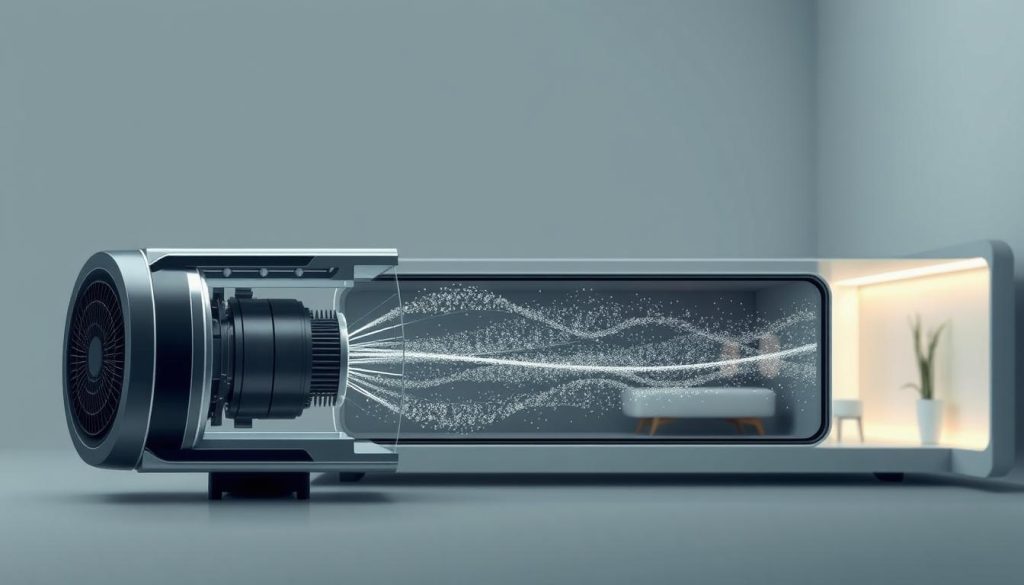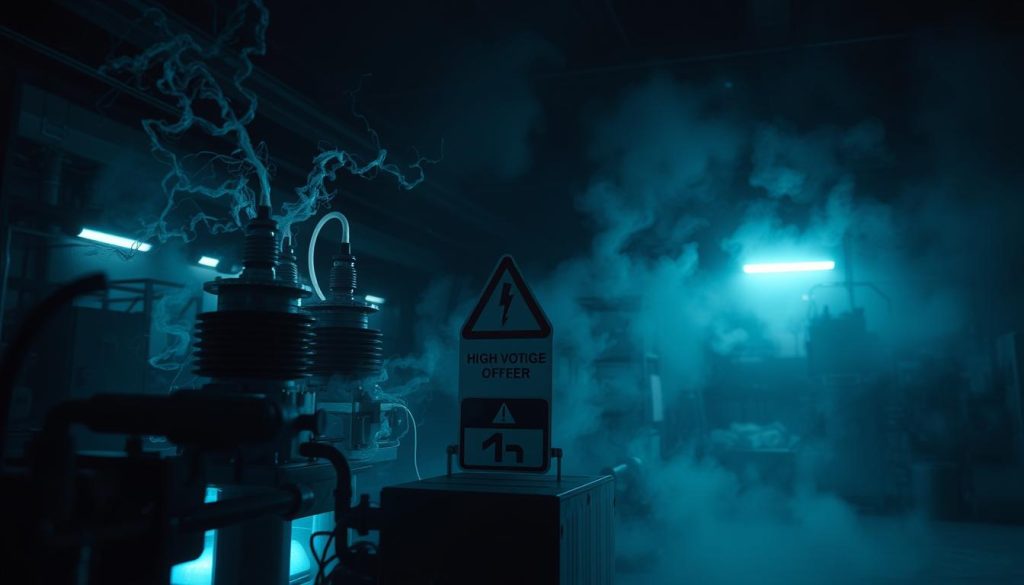In recent years, people have become more interested in ionization for better indoor environments. Many find air ionization to be a game-changer for a healthier home and workspace. The link between ionization and air quality is supported by science and many user stories.
Ionizing technologies are changing how we view air purification. They offer a practical way to remove pollutants and allergens that harm our health. This article explores the science of ionization, its benefits, and how to use it for a cleaner, healthier space.
The Science Behind Ionization
Ionization is a key process for better air quality. It’s important to know how it works to understand its benefits. Each ionization method has its own strengths, making it crucial to learn about them.
How Ionization Works
The air ionization process creates charged particles, or ions. These ions interact with airborne pollutants. An electrical charge makes positive and negative ions that stick to dust, pollen, and bacteria.
This interaction can either neutralize or make these contaminants heavy enough to fall out of the air. This results in cleaner, healthier air.
Types of Ionization
There are several ionization methods, each with its own way of working:
- Bipolar Ionization: This method creates both positive and negative ions. These ions work together to attract and neutralize pollutants. Bipolar ionization is effective in many settings, including HVAC systems and portable air purifiers.
- Corona Discharge: Corona discharge uses a high-voltage electrical field to create ions. These ions attach to airborne particles. This technique is commonly used in industrial and commercial settings for large-scale air purification.
Effect on Air Particles
Ionization has a big impact on air particles. It’s important to understand how it purifies the air. Both bipolar ionization and corona discharge effectively change harmful particles, making them no longer a threat in the air.
| Ionization Method | Mechanism | Common Applications |
|---|---|---|
| Bipolar Ionization | Generates positive and negative ions | HVAC systems, portable air purifiers |
| Corona Discharge | High-voltage electrical field | Industrial, commercial air purification |
Importance of Indoor Air Quality
Keeping indoor air clean is key for our health and happiness. Since we spend a lot of time inside, having clean air is crucial. It helps improve our overall quality of life.
Health Impacts
Poor air quality can lead to breathing problems, allergies, and make existing health issues worse. Pollutants like VOCs, mold, and dust particles can harm, mainly children and the elderly.
Common Indoor Pollutants
Many pollutants can harm indoor air quality. VOCs from paint and cleaners, mold in damp spots, and dust and pet dander are examples. It’s important to tackle these to keep our air healthy.
Monitoring Air Quality
Monitoring air quality is essential to catch and fix pollution issues. Air quality monitors give us real-time data. The EPA and other organizations offer tools and advice to keep our air clean.
Ionization Benefits for Air Purification
One of the key advantages of air ionization is its ability to clean indoor air. It creates negative ions that pull and neutralize harmful particles. This includes dust, pollen, and smoke, making the air healthier.
Research shows that ionization is very effective in cleaning indoor air. It can greatly reduce allergens, helping those with allergies and asthma. It also kills bacteria and viruses, which helps stop infections from spreading.
Ionization does more than just clean the air. It also gets rid of bad smells, making places smell fresher. This is great for homes, offices, and hospitals, where a nice smell is important.
Another big plus is how easy it is to add ionizers to HVAC systems. This boosts the ionization effectiveness and keeps the air clean all the time.
How Negative Ions Improve Air Quality
Negative ions are key to better indoor air. They grab onto pollutants, helping to remove them from our air. They also cut down on allergens, making spaces safer for those with allergies. Plus, they fight off bacteria and viruses in the air.
Binding with Pollutants
Negative ions latch onto dust, pollen, and smoke. This makes these particles heavier, so they fall to the ground. This helps clean the air by removing harmful stuff.
Reducing Airborne Allergens
Negative ions are great at reducing allergens. They stick to allergens like pet dander and mold spores, keeping them from floating around. This cuts down on allergic reactions and breathing problems, making spaces more comfortable.
Neutralizing Bacteria and Viruses
Negative ions have strong anti-microbial effects. They mess with the cells of bacteria and viruses, making them harmless. This is good for stopping the spread of sickness and keeping indoor spaces healthy.
Choosing the Right Air Ionizer
Choosing the right air ionizer is important. You need to think about the room size, device type, and health needs. This helps you make a better choice.
First, consider the room size. Larger rooms need more powerful ionizers. Smaller rooms do well with compact models. The right size ensures clean air and efficiency.
Then, look at the different types of ionizers. You can choose standalone units, integrated HVAC systems, or portable models. Each has its own benefits. Pick the one that fits your lifestyle and home.
Think about your health needs too. If you have asthma or allergies, look for devices with HEPA filters. Some models also have UV light for killing germs. These are great for keeping the air clean.
Lastly, check the brand reputation and customer reviews. Brands like Dyson, Coway, and Blueair are known for quality. Reading reviews and doing research helps find the best ionizer for you.
Understanding Ionization Technology
Ionization technology has grown a lot in recent years. It’s now more advanced. This is because people care a lot about clean air in their homes. The latest air ionizers are changing how we purify the air.
Different Technologies in the Market
Today, there are many ionization technologies available. Each has its own benefits. Here are some main types:
- Corona discharge ionizers
- Photoionization ionizers
- Ultraviolet germicidal irradiation (UVGI)
Corona discharge ionizers use a high-voltage electric field to create ions. Photoionization uses light to make ions. UVGI kills bacteria and viruses with UV light. Each technology meets different needs.

Comparing Traditional and Modern Ionizers
Traditional ionizers and modern ones are different. Old ones use static electricity and cover small areas. New ones use advanced tech for better coverage and efficiency.
Here’s a comparison of some key features:
| Feature | Traditional Ionizers | Modern Ionizers |
|---|---|---|
| Coverage Area | Small | Large |
| Efficiency | Moderate | High |
| Technology | Static Electricity | Multifunctional (UVGI, Photoionization, etc.) |
| Maintenance | Periodic | Minimal |
Modern ionizers clean the air better and need less upkeep. They’re a great choice for many.
Clean Air Solutions for Homes
Creating a healthy home starts with good air purification. Using ionizers with HVAC systems and portable air ionizers are popular choices. They help make indoor air fresh and clean.
Integrating Ionizers with HVAC Systems
Adding ionizers to HVAC systems is a smart way to purify home air. It helps remove dust, mold, and allergens. Ionizing devices are placed in ducts or in the HVAC system.
This ensures clean air flows everywhere in the house.
Portable Ionizers for Personal Use
Portable air ionizers are great for quick air quality fixes. They’re small and work well in single rooms or areas. These devices are easy to move and set up, making them a handy choice.
Improved Air Circulation with Ionization
Ionization greatly improves air circulation. It creates negative ions that help move air better in many places. This makes sure fresh air spreads evenly.
Good air circulation is key for clean indoor air. Homes, offices, and stores all benefit from it. Ionizers keep air moving, pushing pollutants towards filters.
Research shows ionization in HVAC systems boosts air exchange. This makes heating, ventilation, and cooling more efficient. It also saves energy, making it a smart choice.
Dr. Karen Dannemiller from Ohio State University says better air flow means fewer pollutants. It’s not just cleaner air. It’s also healthier and more comfortable.
In short, ionization technology is a big step up for better indoor air. It improves air flow and manages pollutants well. It’s a key part of modern air purification.
Addressing Concerns About Ionization Safety
Ionization technology for air purification has raised important safety questions. A major concern is the emission of ozone, a byproduct that can harm health.

Ozone Concerns
Ozone generation risks are a big issue with ionizers. While ozone can kill some pollutants, too much can cause breathing problems and other health issues. It’s important to use ionizers that follow strict rules to limit ozone production.
Safety Certifications and Standards
Many modern ionizers meet strict safety standards to address these concerns. Certifications from groups like UL (Underwriters Laboratories) and CARB (California Air Resources Board) show they are safe. These certifications mean the products don’t make harmful ozone levels.
Knowing these safety standards helps people choose the right air purification device. It ensures the device works well and is safe for health.
Case Studies: Successful Implementation of Ionization
Ionization technology has shown its worth in many real-world uses. It’s a big help for both homes and businesses. Let’s look at some examples that show how ionization improves air quality at home and in offices.
Residential Examples
Many families in different places have seen better air quality thanks to ionizers. In Seattle, a family with allergies noticed a big drop in symptoms after using an air ionizer. They also saw less dust and a cleaner home.
In Texas, a homeowner put an ionizer in their HVAC system. This led to fewer asthma attacks and allergic reactions. These stories show how ionization can really make a difference in homes.
Commercial Success Stories
Ionization technology works well in businesses too. For example, a famous hotel chain added ionizers to improve air quality. Guests loved the clean air, making the hotel a top choice for health-aware travelers.
A big company in New York also used ionizers in their offices. Employees got sick less often and worked better, thanks to the cleaner air. These stories prove that ionization can greatly benefit businesses.
Understanding the Costs and Benefits of Ionizers
Buying an air ionizer means looking at both the upfront and long-term costs. An ionizer cost-benefit analysis shows that the initial price and setup can be high. But, the long-term health gains often make it worth it.
When you do a deep dive into the economics of air ionization, you need to consider a few things:
Maintenance is usually easy and cheap, needing little upkeep over time. The energy use is also low, which helps keep costs down. People often say they feel better and have cleaner air, which makes them happy with their choice.
| Factors | Details |
|---|---|
| Initial Costs | Cost of the device and installation fees. |
| Maintenance | Low maintenance required, mainly filter replacements if needed. |
| Energy Consumption | Comparable or lower energy use than other purification systems. |
| Long-term Health Benefits | Less respiratory problems and allergy symptoms. |
| User Satisfaction | Many positive comments on better air quality and health. |
Understanding the ionizer cost-benefit analysis helps people make smart choices. The economics of air ionization show that while there are upfront costs, the health benefits and satisfaction make ionizers a good investment for many.
Future of Air Quality Improvement with Ionization
Looking ahead, ionization technology is set to change how we clean the air. New sensors and data tools will lead to big improvements. We’re seeing more chances for everyone to use ionization technology.

Innovations in Ionization Technology
New trends show smart air quality systems and better ionization controls are coming. Nanotechnology will make air cleaning more effective. We’ll also see smaller, energy-saving devices for homes and businesses.
Potential for Wider Adoption
Research and awareness are growing, making ionization more popular. Experts predict a big increase in use in homes, offices, and factories. Cities are also planning to use ionization to fight pollution.
These advancements and the push for clean air will make ionization key in improving air quality. It’s becoming a must-have for keeping our air healthy.
Ionization and Air Quality Improvement: A Clear Win
Ionization is a big step forward in air quality. It works by attracting pollutants or reducing allergens in the air. This makes our indoor spaces cleaner and healthier.
Studies show ionization’s benefits in many places. From homes to offices, it’s making environments better. You can use it with your HVAC or as a portable unit.
Some worried about safety, but new ionization tech meets strict standards. It doesn’t produce harmful ozone. As tech gets better, more people will use ionization. It’s a smart choice for better air and health.

